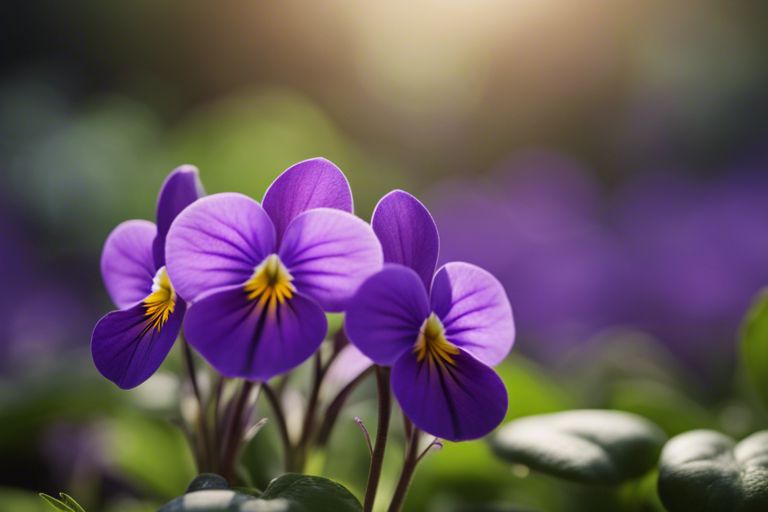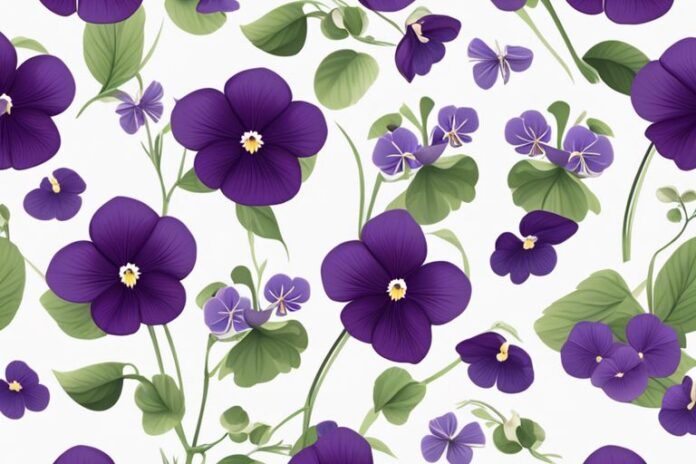Identification of violets is vital for both novice botanists and gardening enthusiasts alike, as these delicate blooms come in various shapes, sizes, and colors. In this comprehensive guide, we will investigate into the distinctive characteristics of violets, including their unique heart-shaped leaves, five-petaled flowers, and vibrant hues ranging from deep purples to soft whites. Understanding how to properly identify violets is crucial, as many species are cherished for their beauty in gardens while others can be harmful if ingested. Let’s explore the intriguing world of violets and learn to differentiate these charming flowers from their look-alikes.
Key Takeaways:
- Violets have heart-shaped leaves: The distinctive heart-shaped leaves of violets are a key characteristic for identification.
- Flowers come in a variety of colors: While often purple or blue, violets can also be found in shades of white, yellow, and even pink.
- Five-petaled flowers with unique markings: Violets typically have five petals and may have distinct markings like stripes or dots.
- Low-growing, delicate plants: Violets are typically small, delicate plants that grow close to the ground.
- Cultivated and common in many regions: Violets are popular garden plants and can be found in various habitats around the world.
Understanding Violets
You may have seen violets growing in your garden or while taking a stroll in the woods, but do you truly know what these delicate flowers look like? Let’s examine deeper into the world of violets to understand their unique characteristics and beauty.
Botanical Profile of Violets
On a botanical level, violets belong to the Viola genus, encompassing hundreds of different species of flowering plants. These plants typically feature heart-shaped leaves and five-petaled flowers that come in various colors such as purple, blue, white, and yellow. Violets are known for their distinct fragrance and are often used in cosmetics and perfumes.
Different Types of Violets
While exploring the diverse world of violets, you will encounter various types such as the Common Blue Violet, Wild Pansy, Canada Violet, Sweet White Violet, and Woolly Blue Violet. Each type has unique characteristics in terms of leaf shape, flower color, and growing conditions. Perceiving these differences can enhance your appreciation for the beauty of violets.
| Common Name | Characteristics |
|---|---|
| Common Blue Violet | Deep purple petals with heart-shaped leaves |
| Wild Pansy | Yellow or purple flowers with conspicuous dark lines |
| Canada Violet | Lavender blooms with delicate veins |
| Sweet White Violet | White flowers with a sweet fragrance |
| Woolly Blue Violet | Blue-violet flowers with fuzzy leaves |
Types of Violets
On your journey to identify violets, it’s necessary to familiarize yourself with the most common types found in your region, dangerous look-alikes that should be avoided, and positive attributes that make violets a beloved flower among gardeners. By understanding these distinctions, you can confidently recognize violets in diverse landscapes.
| Aspect | Details |
|---|---|
| Common Types | Recognizable characteristics of popular violet species |
| Dangerous Look-Alikes | Similar-looking plants that can be harmful if misidentified |
| Positive Attributes | Benefits of violets in gardens, ecosystems, and herbal remedies |
| Distinct Features | Key traits that differentiate violets from other flowers |
| Growth Patterns | Insight into how violets spread and thrive in various environments |

Step-by-Step Identification of Violets
| Step 1: Examine the Leaves | Step 2: Observe the Flowers |
| Step 3: Check the Stem | Step 4: Evaluate the Habitat |
Factors to Consider When Identifying Violets
Identifying violets involves considering several factors. Leaf shape, flower color, stem structure, and growing environment are crucial. Size variation within violets is common, so use multiple characteristics for accurate identification. Recognizing these distinctions is key to identifying violets correctly.
Tips for Accurate Identification
To ensure accurate identification of violets, pay attention to leaf margins, flower petal shape, and the presence of spurs on the flower. Smell can also be a distinguishing factor in some species. After examining these features, cross-reference with field guides or botanical resources for confirmation.
- Leaf margins
- Flower petal shape
- Spurs on the flower
More Information on Tips for Accurate Identification
Identification of violets can be challenging due to their intricate details. Pay close attention to the veining pattern on leaves, hairiness of stems, and any notable scent emitted by the plant. After thorough examination, consult with a botanist or use online resources for further assistance.
- Veining pattern on leaves
- Hairiness of stems
- Presence of scent
Cultivation and Care of Violets
Once again, let’s research into the fascinating world of violets and explore how to cultivate and care for these delicate yet resilient plants.
How to Grow Violets: A Step-by-Step Approach
Any successful violet cultivation begins with proper understanding and implementation of key growing practices. Refer to the table below for a step-by-step guide:
| Step 1: | Choose a well-draining potting mix |
| Step 2: | Provide ample sunlight |
| Step 3: | Water consistently but avoid over-watering |
| Step 4: | Fertilize periodically |
| Step 5: | Monitor for pests and diseases |
Pros and Cons of Growing Violets
Pros and cons of growing violets are important to consider before begining on your violet-growing journey. Refer to the table below for a comprehensive list:
| Pros | Cons |
| Beautiful blooms add aesthetic appeal | Susceptible to root rot if overwatered |
| Low maintenance plants | Require specific light and temperature conditions |
| Available in a wide range of colors | May attract certain pests like aphids |
Violets, with their captivating beauty and relatively easy care requirements, can be a delightful addition to any indoor or outdoor garden. However, it’s important to be mindful of the potential pitfalls, such as susceptibility to overwatering and specific environmental needs. By weighing the pros and cons thoughtfully, you can ensure a successful violet cultivation experience that brings an abundance of joy and color to your surroundings.
Conclusion
The guide “What Do Violets Look Like? A Comprehensive Identification Guide” serves as a reliable resource for accurately identifying various species of violets. By providing detailed descriptions of their key physical characteristics, bloom colors, sizes, and preferred habitats, this guide equips readers with the knowledge needed to confidently differentiate violets from similar-looking flowers. With this comprehensive information at hand, enthusiasts and professionals alike can enhance their appreciation and understanding of these charming and diverse plants.
FAQ
Q: What do violets look like?
A: Violets are small, delicate flowers with five petals that can be shades of purple, blue, yellow, or white. They often have distinct veining or patterns on the petals and are known for their unique shape. Violets can range in size from half an inch to two inches in diameter.
Q: How can I identify violets in the wild?
A: Violets can be identified by their heart-shaped leaves, which often have scalloped edges. The flowers grow on slender stems that arise from the center of the leaf cluster. Some violets have a characteristic sweet fragrance, while others may have no scent at all. Pay attention to the color, shape, and size of the flowers to correctly identify violets in their natural habitat.
Q: Are violets edible or toxic?
A: Many species of violets are edible and have been used in culinary dishes and herbal remedies for centuries. However, it is crucial to positively identify the violet species before consuming any part of the plant, as some varieties can be toxic. If in doubt, it is best to err on the side of caution and avoid ingesting violets unless you are certain of their safety.

